
Open Access 2016 | OriginalPaper | Buchkapitel
11. Ongoing Refinement
verfasst von : Samuel Davey, Neil Gordon, Ian Holland, Mark Rutten, Jason Williams
Erschienen in: Bayesian Methods in the Search for MH370
Verlag: Springer Singapore
Aktivieren Sie unsere intelligente Suche, um passende Fachinhalte oder Patente zu finden.
Wählen Sie Textabschnitte aus um mit Künstlicher Intelligenz passenden Patente zu finden. powered by
Markieren Sie Textabschnitte, um KI-gestützt weitere passende Inhalte zu finden. powered by